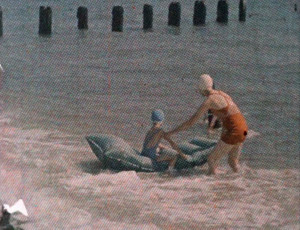
"Nineteen thirties holiday film of the Harrison family at a number of Suffolk coastal holiday hotspots; including Southwold, Lowestoft, the Broads (Beccles), and Thorpeness. This reel, with scenes in both Dufaycolor and black and white, shows the family having a jolly old time bathing, picnicking at their beach hut, horse riding, and sailing. Intertitles include “Susan on the li-lo” and “tea with the mater” (BFI.org.uk)
"Item is a production of Dr. Willinsky's trip to Spain with his wife, Sadie. In the form of a travelogue, footage of landmarks, historic sites, and the local population is interspersed with captions and maps that were added in by Dr. Willinsky to denote locations and provide context. The production includes footage from Madrid, Cordoba, Segovia and Valencia. Sadie is occassionally spotted exploring sites and interacting with locals and travel companions who are probably family friends or relatives." Ontario Jewish Archives.
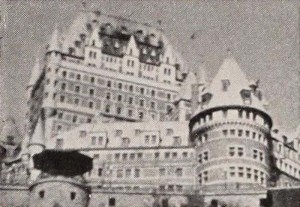
"When you ramble about on a cinematic tour of old Quebec in Carl Nerish's St. Lawrence Sketches, you feel that here at last is a new and different theme for the travel film. The Old World atmosphere of that delightful city is shown with loving sympathy. One of the outstanding points is a clever and human continuity device employed to carry the story along during a tour of the city in a horse drawn carriage. Spoken titles are used with striking closeups of the quaint cab driver who is pointing out the sights to Mr. Nerish and his audience. By studying each shot of the driver, Mr. Nerish was able not only to present a varied series of shots of him, but also to show enough background material to add a good deal to the scenes presented in the regular course of the film. Equally effective are the shots of people in the market place, where a telephoto enables Mr. Nerish to get unposed views. A carefully chosen, but somewhat detailed, musical background was played throughout the film, and it served in no small measure to lend atmosphere to the production. Special credit is due the filmer for his precisely executed titles. Such painstaking work as that involved in centering and lining up movable title letters is seldom seen." Movie Makers, Dec. 1939, 632.
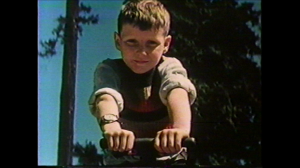
"This film captures (in excellent pre-war Kodachrome) a day in the life of Stanley Park. An early effort at independent documentary production by a group of Vancouver film enthusiasts, including amateur cinematographers Oscar Burritt and Don Lytle. The Coast Films group intended to produce a series of films that could be distributed by the fledgling National Film Board of Canada, but World War II intervened, and this was their sole group effort. Stanley Park was restored in 1987 by the British Columbia Archives." (BC Archives)
"Stanley Park is a languid but lyrical look at flora and fauna, people at play, and the traffic of cars and ships in and around the park. . . . The excerpt shown here [on the AMDB] is the middle third of a 16-minute film [at 24 frames/second]. We see people arriving at the park on a weekend--by streetcar, by car, and on foot. The next sequence shows a very large audience watching a concert performance at Malkin Bowl. (The three young women on stage have probably just finished singing "Three Little Maids from School" from The Mikado.) There's an engaging sequence of children playing on the swings and seesaws; then there's footage of adults playing checkers and tennis, and another large crowd enjoying a cricket match. Scenes along the beach and the seawall (including the Second Beach Pool) lead into shots of boats and steamships sailing near First Narrows, and an ocean liner passing under the recently-completed Lion's Gate Bridge. Charles Marega's handsome Art Deco stone lions, poised at the eastern approach to the bridge, are shown in close-up." -- Seriously Moving Images, July 2025.
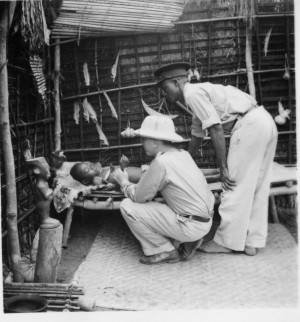
"The Story of Bamba is a drama filmed in Africa by Ray L. Garner for the Harmon Foundation in New York. This reviewer calls the production a film drama advisedly, for, although it is made as a report of the medical work of a missionary group in Africa, the picture is, in itself, an entertaining photoplay. The boy, Bamba, is the nephew of the tribal witch doctor who cures sickness with his fetishes. Bamba is to become the medicine man's successor, but he falls ill with the fever and is deserted by the tribe when they hurriedly flee their village to rid themselves of a plague. Rescued and cured by the native representative of the missionary medical center, Bamba is sent to school so that he too, can cure in the white man's way. An adult, he returns to his own tribe, where he meets and finally overcomes the resistance of his uncle. Thus, the plot unfolds clearly and entertainingly, yet the story does not interfere with a complete exposition of the medical work of missionaries. Skillful handling of native actors is apparent in every scene, for there is scarcely an unconvincing piece of business in the whole film. Camera treatment is matter of fact but adequate." Movie Makers, Dec. 1939, 637.
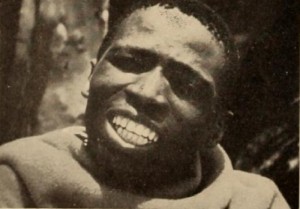
"Through the eyes and experiences of Matsela, a statuesque native of Basutoland, South Africa, Lewis Lewis reveals a stirring story of the triumph of modern agricultural science over the warring elements of nature. The account of how Matsela and his people all but perish in the dust bowl created by malevolent storms and drought, how he studies under a government program of soil reclamation and triumphantly puts his new training to work, provides an absorbing drama and an enlightening document on one of the world's grave problems. Although dealing with literal facts, Mr. Lewis dramatizes the incidents in his story with telling skill. Superb camera work and an attractive variety of viewpoints aid the dramatic effect, while a fascinating score of native songs further enhances the presentation. Save as a scientific record, the film is somewhat overlong, with the second of three 900 foot reels regrettably slow paced after the swift excitement of the opening chapter." Movie Makers, Dec. 1949, 455.
"A rather thorough glimpse of the little town of Salzburg, Austria, is given to us in this well constructed little film. We find music, distinctive dress, churches, parks, and people. The narrator and the sound track go a long way towards amplifying the mood that is created by the visuals" PSA Journal, Sept. 1966, 36.
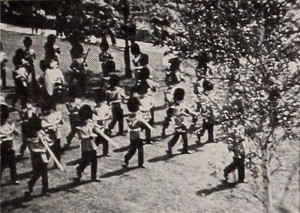
"In Streets of Peace, Lewis B. Sebring, jr., presents a manifold accomplishment in film. Here is a record of the New York World's Fair 1939, but a record which, because of its selectivity, gives the impression of completeness in setting forth a single theme, although the material is both voluminous and varied. Here, also, is an interpretation of the epic idea behind the foreign participation in this great American exposition, the vision of peace, which has since been so rudely interrupted. Mr. Sebring takes his camera through the streets of peace, literally, and we see one after another of the foreign buildings and exhibits at the Fair; we also look at the different national celebrations in the Court of Peace. The visit of the King and Queen of England is recorded in considerable detail. After a scene of children of many lands uniting in a gathering in the Children's World, we find the pointed query as to what these youngsters will make of the "world of tomorrow," and the picture closes with distinguished shots of the United States Building, with its flag and the word "Peace," which appears on its façade. Mr. Sebring's titling is admirable, both in wording and in execution. His Kodachrome exposures have less good moments, but his camera handling is otherwise pleasing. Here is a workmanlike and finished recording of a great international event." Movie Makers, Dec. 1939, 635-636.
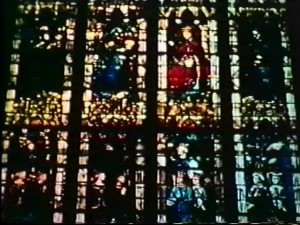
"Studies in Blue and Chartres Cathedral, a cerulean cinema achievement, one 400 foot reel in full Kodacolor by John V. Hansen, ACL, shows what an artist's and a colorist's eye can select and record. While this film is in some sense a travel record, Mr. Hansen definitely made it a point to choose those scenes and vistas that revealed the open sky, whether seen in patches through the interlaced branches of trees or as a dim, distance haze, shimmering up from the tops of far off mountains. Here are deep blue skies overhead, merging into white mist at the horizon, apple green, azure, so many hues that it is a revelation to see that a mechanical process can so beautifully record nature. Mr. Hansen presents to the audience's eyes such a varying kaleidoscope of blending colors in his continuity that it is difficult to do the entire effect justice by mere description. But among his outstanding technical achievements are the recording of sunlit glades in a dense forest, especially effective cloud and sunset shots, distant and close shots and side lighting and backlighting in profusion. A further, outstanding triumph in color technique was shown in Mr. Hansen's recording of the vivid, glowing hues of the stained glass windows, taken from the interior of the cathedral at Chartres. Here, he succeeded in capturing that peculiar, deep dyed transparency found only in the colors of old stained glass. It is questionable if any other method of reproducing color can give such a real and beautiful rendition of stained windows as the motion picture. Certainly no color printing process can compete. The film was rounded out by some charming long shots of the carefully cultivated, rolling hills of Denmark." Movie Makers, Dec. 1932, 538, 560.
"The Suicide Race by Frederick C. Harshbarger, a PSA member of Colton, Calif. Fritz has used his past multi-winning talents to present this most unusual equestrian event that most people don't even know exists, much less have witnessed. This 11-minute 16mm film was awarded an Honorable Mention" PSA Journal, Nov. 1970, 38.
Total Pages: 37